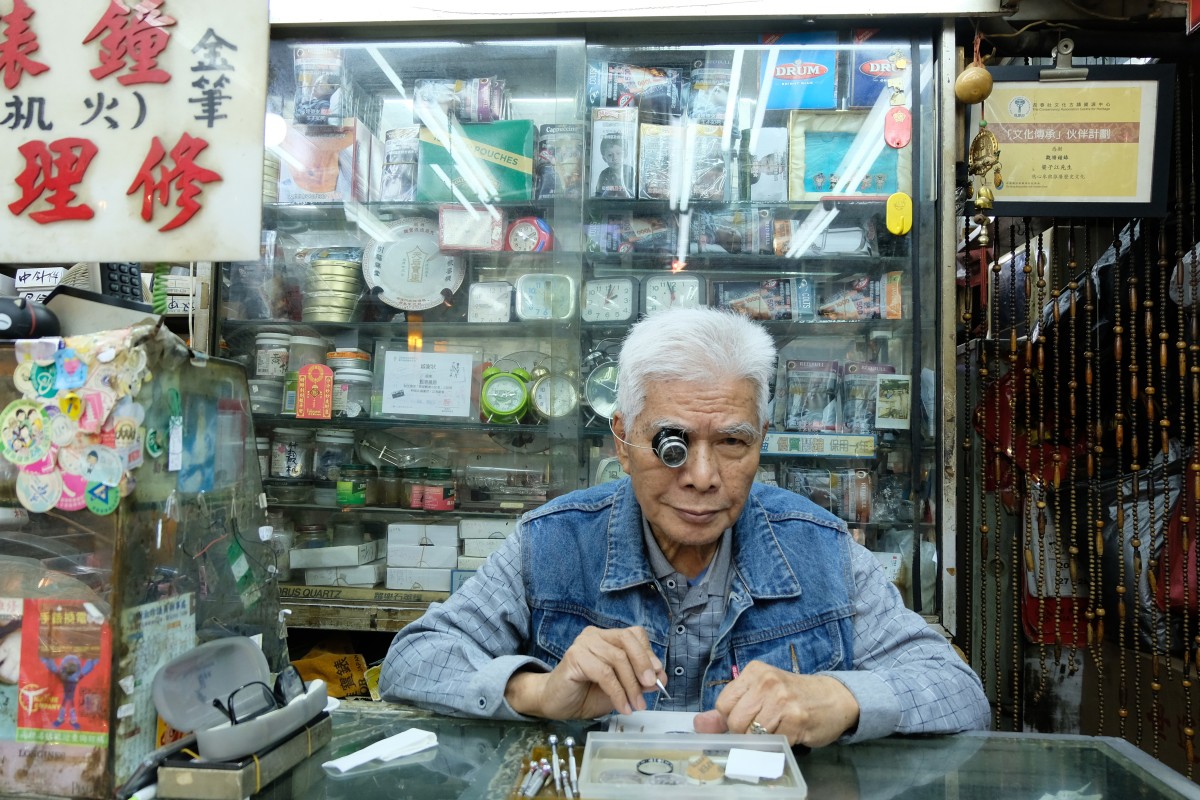
As Yue Man Square's final day approaches, we look at the history and culture that will be lost to redevelopment projects in Kwun Tong
Artisans who've been working for half a century in the famous 'beating heart' of the Kowloon district tell us about this end of an era, and what it means for them.
 How many more seconds does Leung have left with his watch repair shop in Yue Man Square?
How many more seconds does Leung have left with his watch repair shop in Yue Man Square? Mr Leung skilfully removes the second-hand from a watch, holds it up with a steady hand, and peers at it under his lens. A small crowd closes in, snapping pictures, eager to get their last shot of a master craftsman at work before he is forced out of Kwun Tong to make way for glittering hotels and malls.
Yue Man Square has been the beating heart of Kwun Tong for half a century: a selection of local food stores, restaurants, jewellery shops, street stalls and clothing traders, all surrounded by major transport terminals. It is full of local colour and culture – like the affectionately dubbed “Old Mac”, one of Hong Kong’s oldest McDonald’s restaurants, which set a record back in 1981 when it served the largest number of customers in a day globally.
Gallery: Yue Man Square's final days
The square is also a favourite spot for photographers and Instagram-lovers. It was the subject of a winning image in a National Geographic photography contest back in 2016, and features in Wong Kar-wai’s 1995 drama Fallen Angels. However, there’s no denying that the area is prime for redevelopment. Renewed interest in the district brings with it the promise of a better quality of life for locals. Not everyone, though, shares this optimism.
Going to Hollywood for a taste of Hong Kong history and heritage ... Hollywood Rd, that is
It’s hard to believe Leung is 85 years old. He has been fixing watches for nearly half a century. Now, for him and 25 other small business owners, the future looks uncertain, as they fight against widespread closures. Leung, who prefers not to give his full name, has not yet received an official notice from the government. So – for now – he waits, knowing his days are numbered.
The craftsman says he would have liked to pass on his skills to the younger generation, so that they, too, can set up their own shops. Time, it seems, has simply run out. There are a few holdouts against the biggest redevelopment project in Hong Kong’s history, which was first proposed all the way back in 1998.
Fourteen years of hard-fought battles between residents, craftsmen and the government will see Yue Man Square forever changed.
Architectural tours give new life to Hong Kong's old buildings
On Sunday, around 50 people attended a watch workshop taught by Leung. It was part of a larger event, “A Farewell to Yue Man Square”, which was put together by community organisation Living in Kwun Tong. The event included demonstrations by local craftsmen like Leung, a photo exhibition, and a guided tour to say goodbye to Yue Man Square.
Living in Kwun Tong’s chairperson, Yuen Chi-yan, describes the closures as a “dimming of the lights”. He hopes visitors to the farewell event will recognise how much Kwun Tong has been part of Hong Kong’s growth over the past 50 years. He adds that he also wants the public to know that not everyone is getting a good deal out of the redevelopment project. Unlicensed tradesmen, for example, will not get a penny from the government.
“Of course the redevelopment affects my life as we have to leave; we need to earn a living,” says Leung, who is one of the many local vendors not being offered any deal. He notes that business has dropped 50 per cent since the redevelopment project began.
CUHK takes Heep Yunn School students on a Magic Carpet ride through To Kwa Wan
“We have no say,” he points out, “All I want now is reasonable compensation.” He wants to retire with peace of mind. Down the street, there is another small watch repair store where a craftsman known as “the gentleman” works.
Shir Wing-shing is sharply-dressed in a chequered suit and fedora adorned with a crystal pin. For the last 10 years, he has been toiling from noon to midnight from a tiny mobile stall. He’s been trying to get a fixed- pitch hawker licence from the Food and Environmental Hygiene Department since 2010, so that he can work without the constant fear of being caught.
“Redevelopment means improvement for society,” he says. “But, the property giants buy the land and build high-rise buildings; it’s inevitable,” Shir continues. “They leave nothing for the small local stores.”
Shir repeatedly speaks of his love for watches. “I have hope that such traditional crafts can be preserved. But one thing that I cannot easily let go of is the community spirit that exists here…”
As D-Day nears, more voices are emerging from within the community, speaking out against the erasure of a cherished piece of local history and culture by high-rise development. “It’s like a bulldozer,” says Yuen. “It just sweeps away all local colour. It would be great if some of the original culture and character could be preserved in the new Kwun Tong.”
Both Leung and Shir are dab hands at fixing watches, but even they cannot rewind time for Kwun Tong. “It’s inevitable” is the phrase they keep repeating. But as the last seconds slip away for them, sharing the stories of this vanishing city is what we can do to preserve the identity of the 852.
